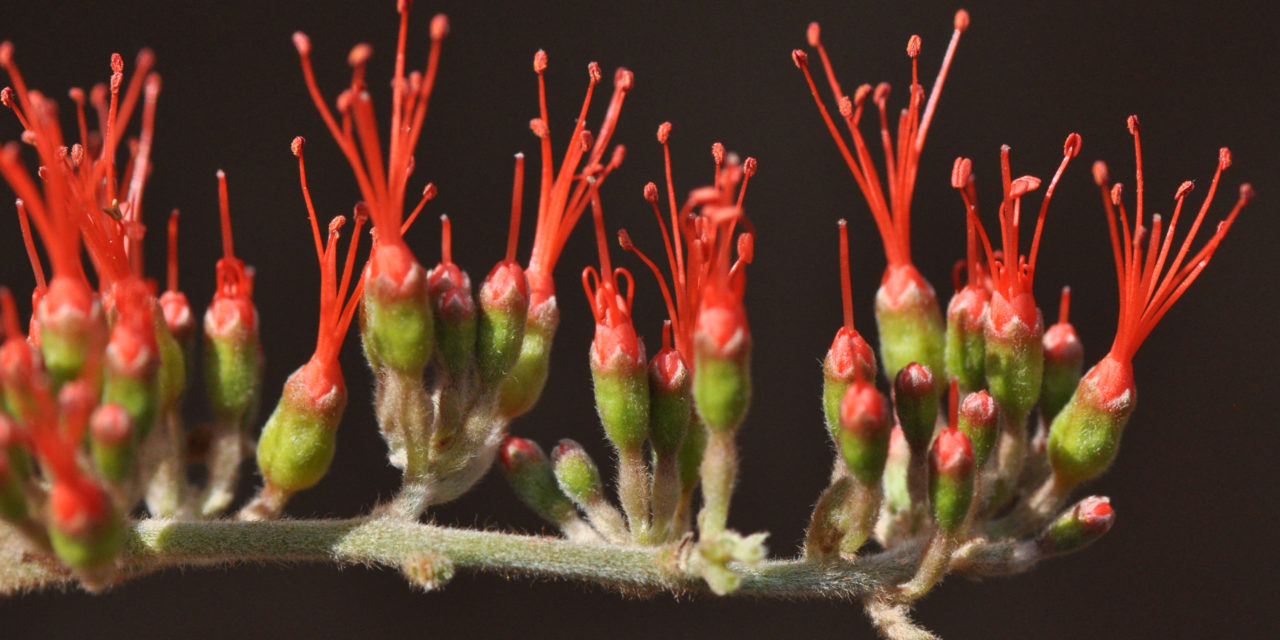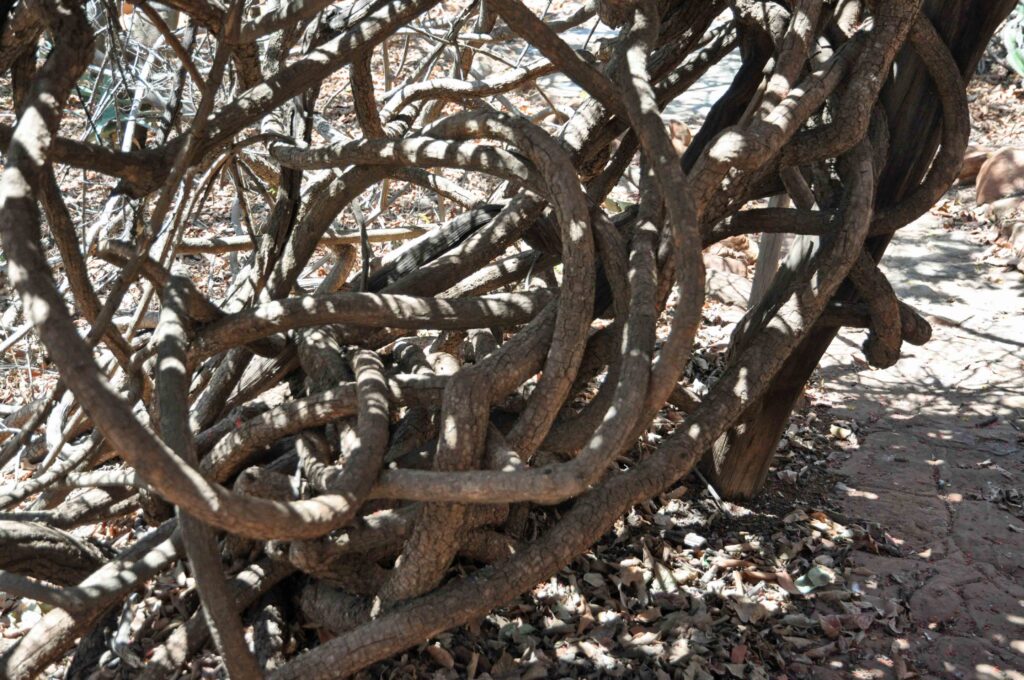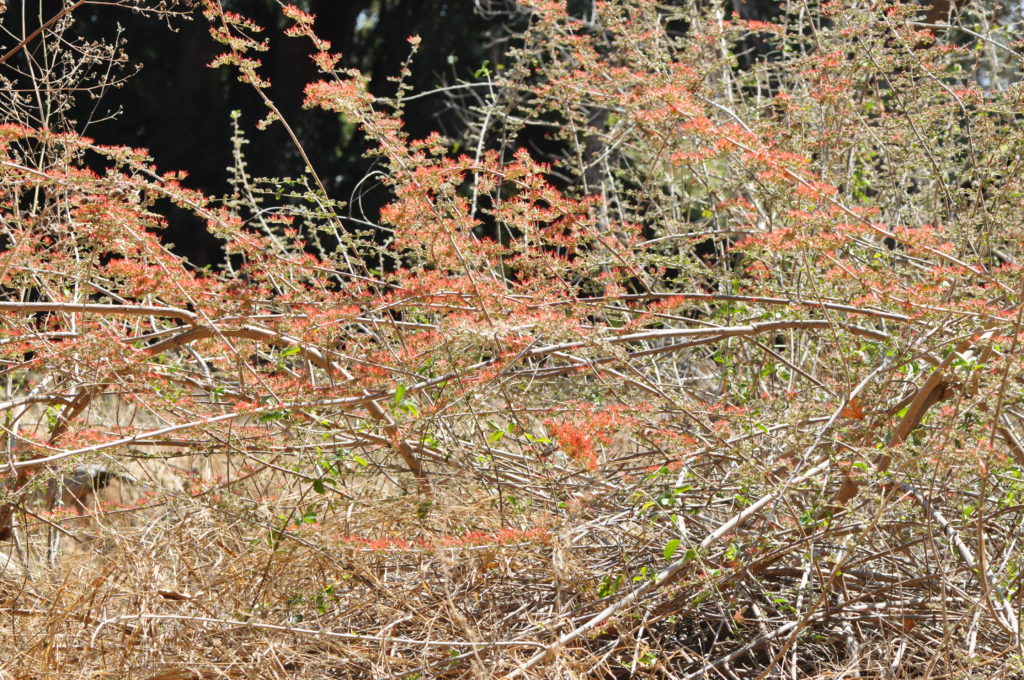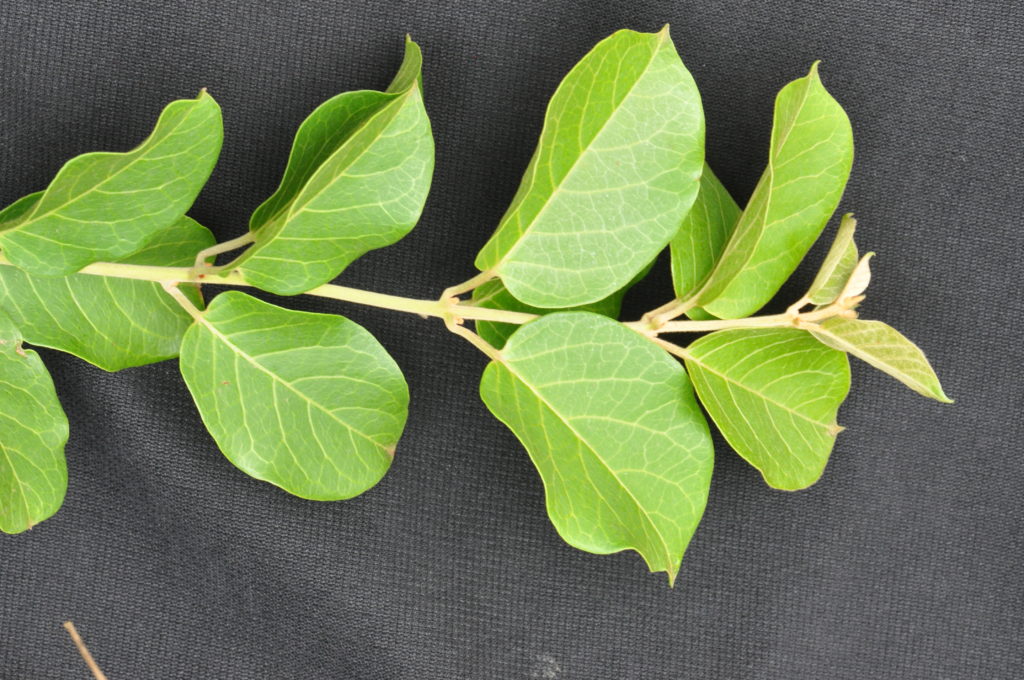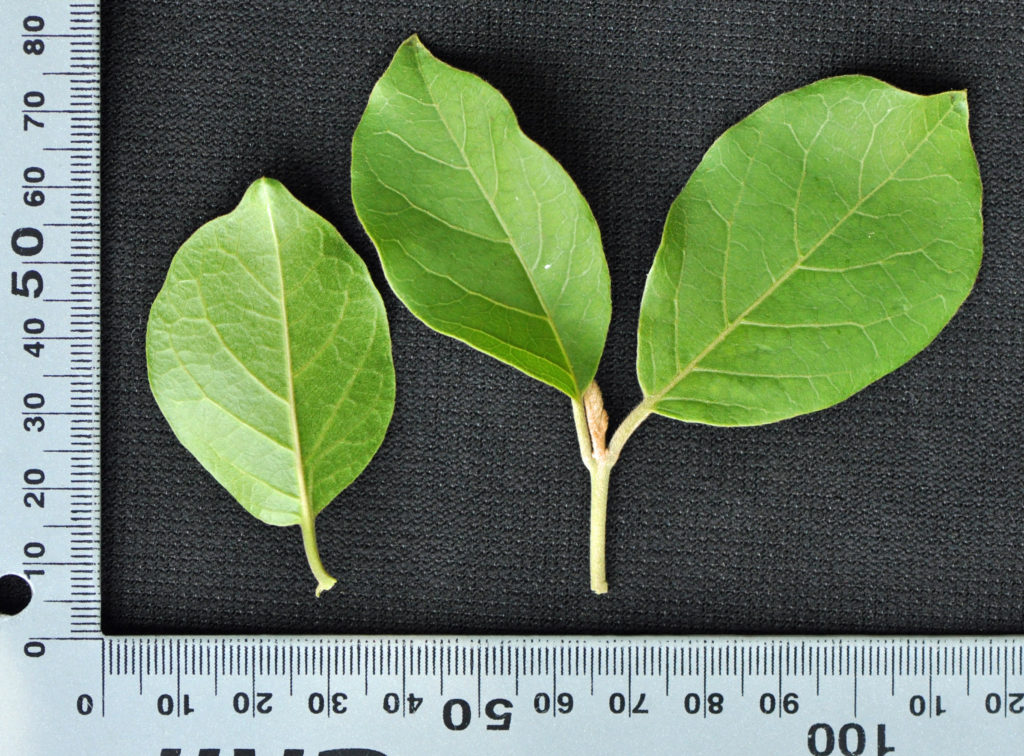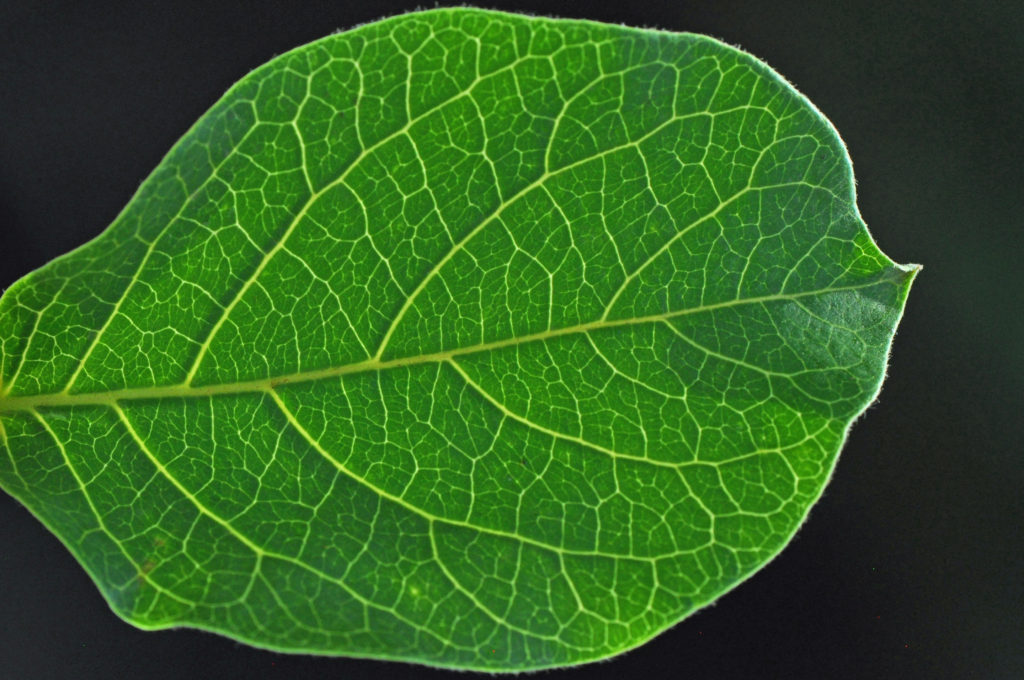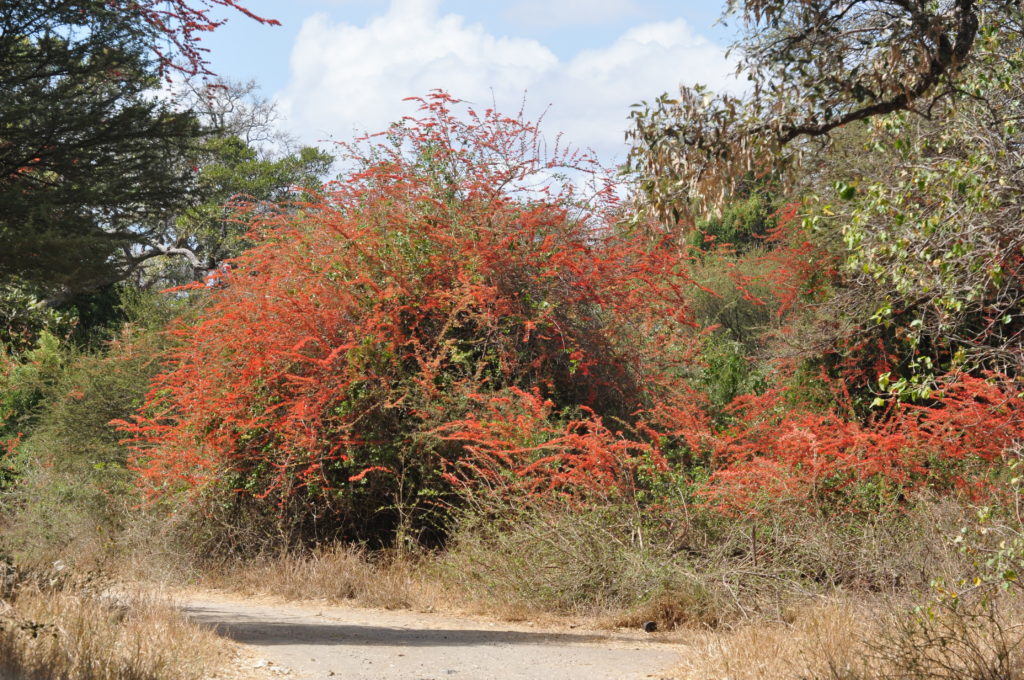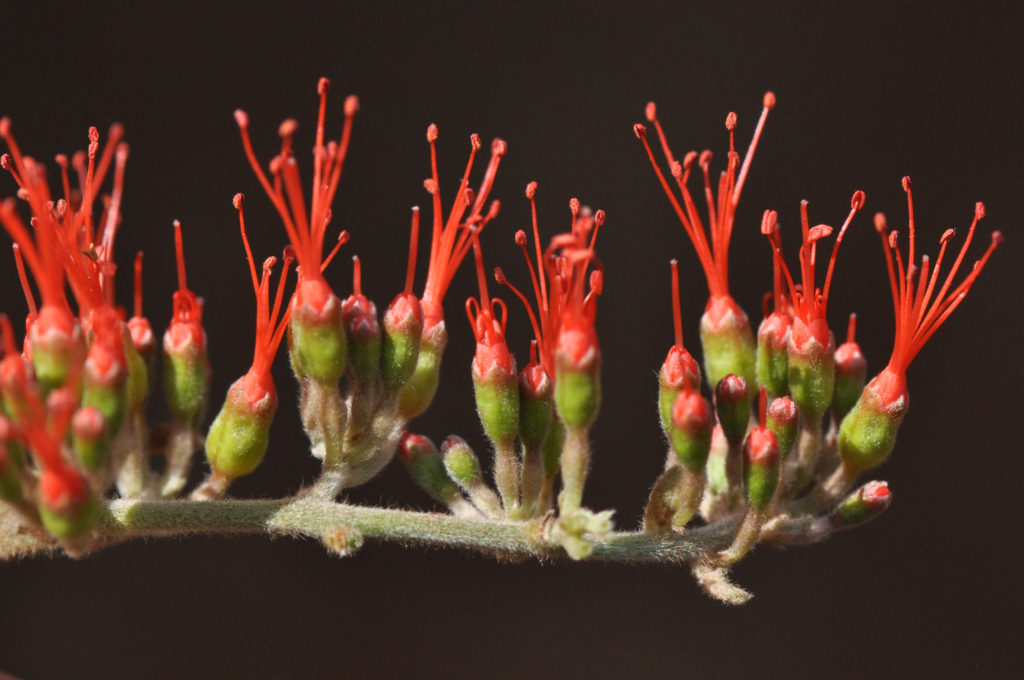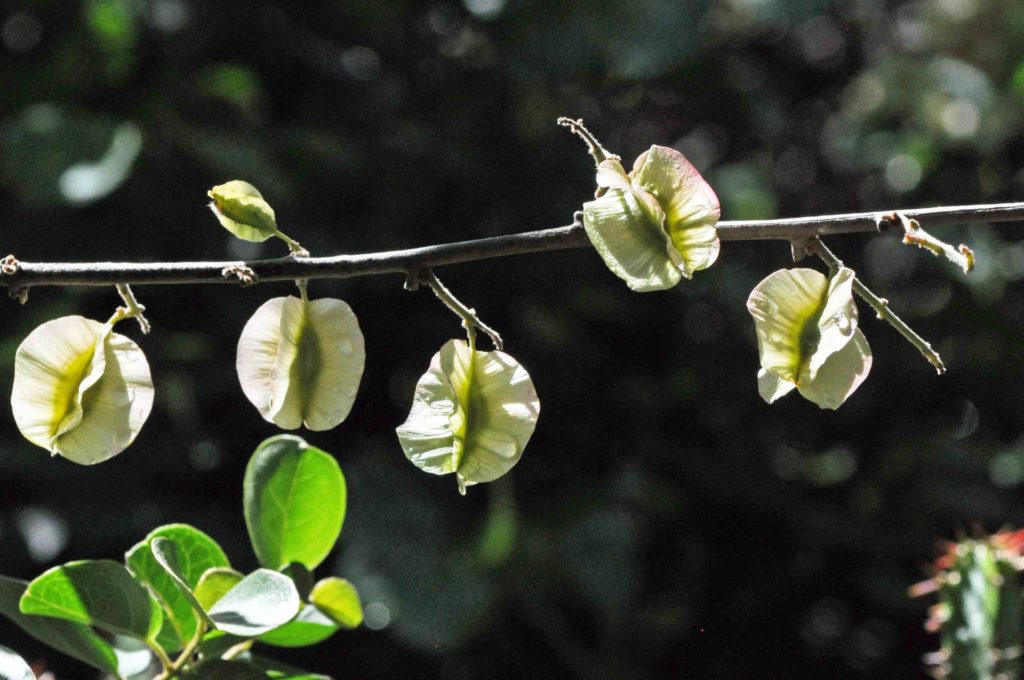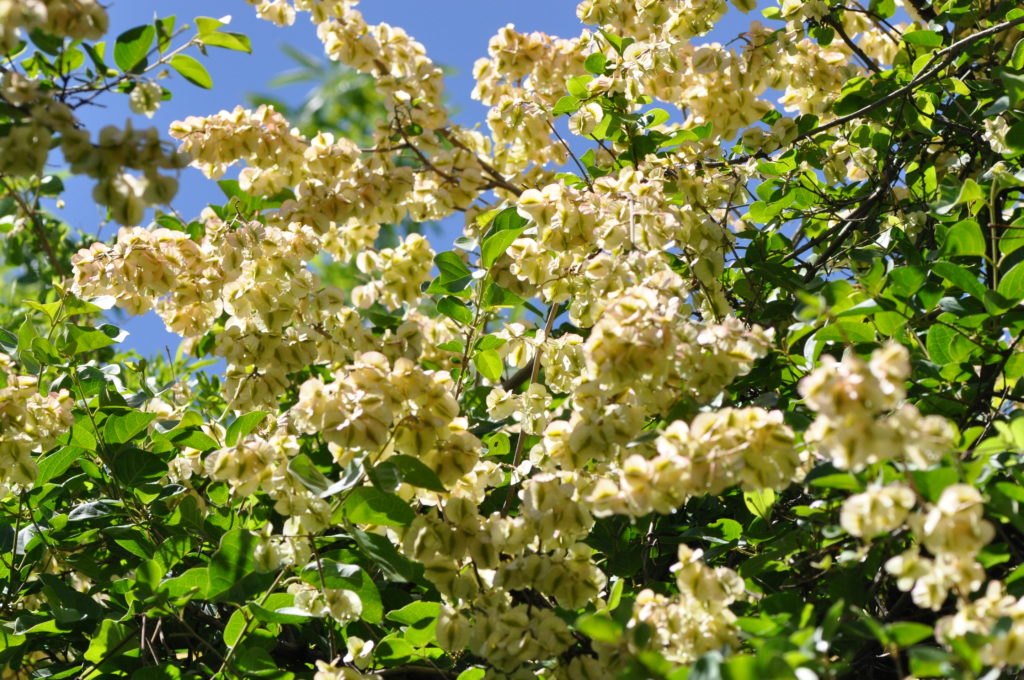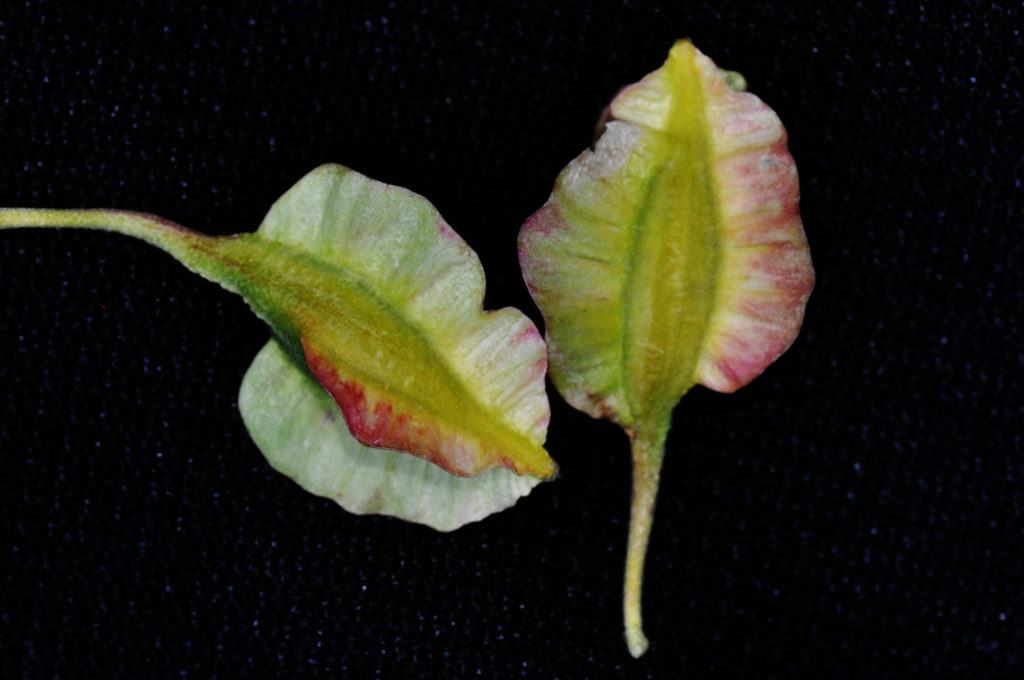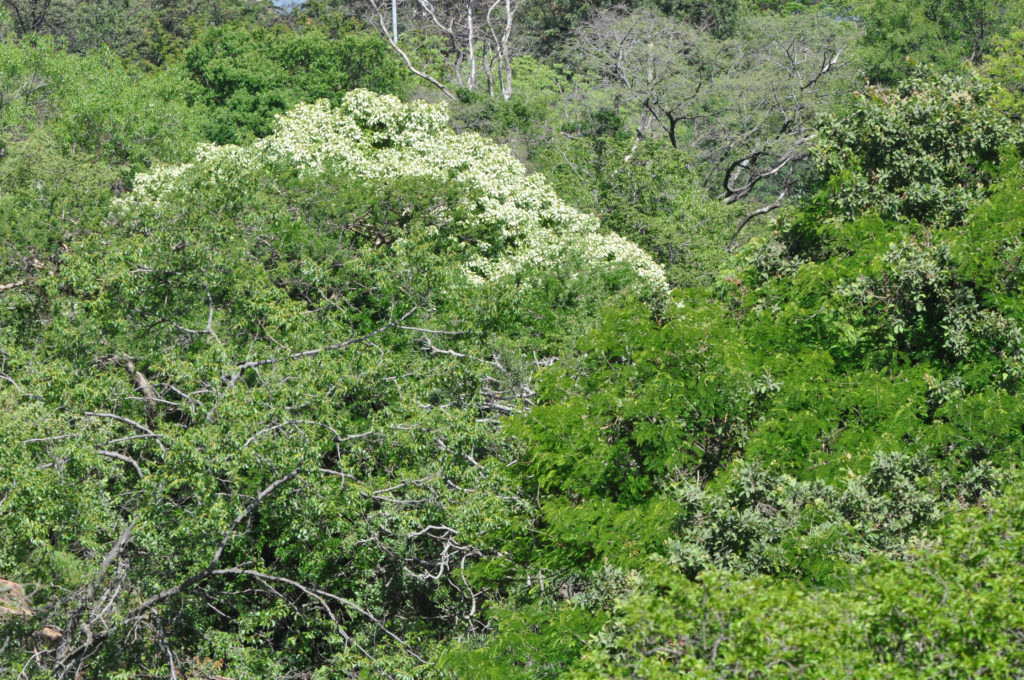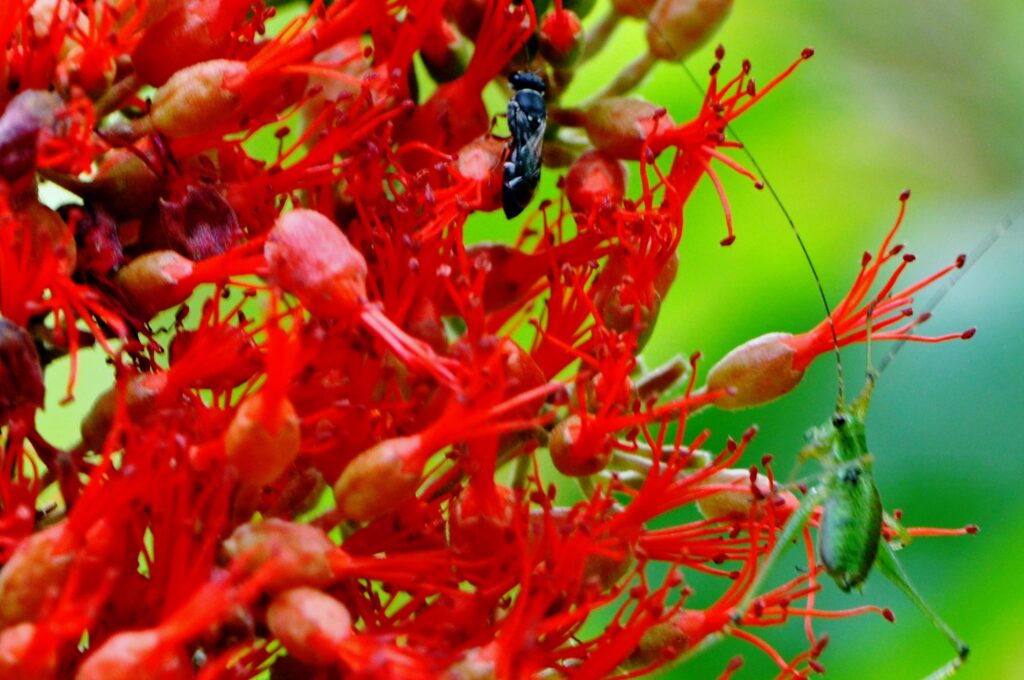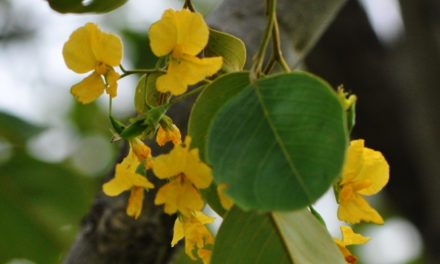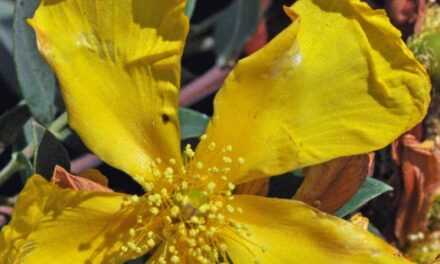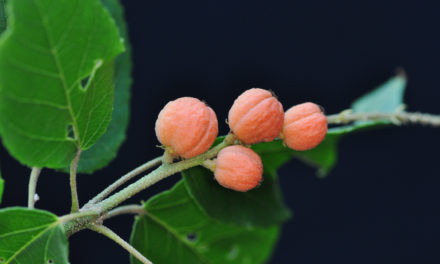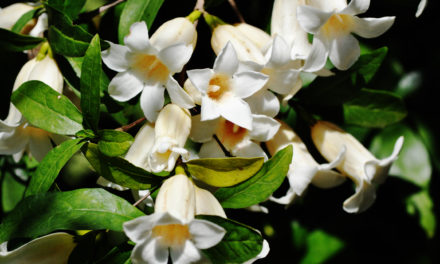General Info – summary
This Tree is up to 4m high but often a multi-stemmed climber/scrambler with long branches. Simple, entire Leaves lack stipules and appear after the flowers. Old petioles may become spiny. The spectacular bisexual, regular Flowers are in spikes. 4 petals, 8 stamens & single styles are all red. Single chambered inferior ovary only resembles a pedicel. The wind-dispersed Fruit is usually a 4-winged, 1 seeded samara.
Description
Previous Names: Combretum paniculatum subsp. microphyllum.
SA Tree No. 545.
Common names: (Afr) Vlamklimop. (Eng) Burning Bush, Burning Bush Combretum, Flame Climbing Bushwillow, Flame Creeper, Riverine flame-creeper, Small-Leaved Bushwillow. (Tshivenda) Gopokopo, Murunda-gopokopo. (Xitsonga) Ntsotsotso, Mpfunta.
Family: Combretaceae (Bushwlillow family). In this family, there are about 16 genera, which contain about 530 species. In South Africa, there are 5 genera and 41 species. Genera with Trees on this website include Combretum, Lumnitzera, Pteleopsis and Terminalia. The simple and usually entire Leaves lack stipules. Flowers are usually bisexual. There are usually twice the number of stamens as sepals or petals. The inferior Ovary has 1 locule and usually only 1 of the ovules develops into a seed. Fruit is usually indehiscent and may be winged or ridged.
Name derivation: Combretum – a climbing plant. microphyllum – small leaves (probably refers to small leaves sometimes found close to flowers – possibly bracts).
Conservation: National Status: L C. (Least Concern). Assessors: Raimondo et al. (2009).
Tree
The Tree may reach 4m in height, and the Trunk 25cm wide. However, this plant is usually a vigorous, multi stemmed (photos 790) woody tree-climber that may reach the tree canopy (photo 635 – under fruit) or become a scrambling shrub (photo 79) or small tree. The Bark becomes rough, pale grey and flaking in old plants. Young flattish branches tend to droop (photo 79) and are hairy (photo 319 under Flowers).
- 790. 2016/10/11. Pretoria NBG. Photo: David Becking.
- 79. 2014/08/31. Mapungubwe NP. Photo: David Becking.
Leaves
On this usually deciduous plant, the thinly leathery Leaves may be alternate, opposite or 3-whorled (photo 527). Leaves are simple (have a single blade which may have incisions that are not deep enough to divide the leaf into leaflets). The new leaves appear after the flowers. Leaf size varies around 3-5cm (photo 362). The leaves are ovate, obovate (egg-shaped – with the narrower end at the base) or oblong-elliptic to almost circular. Young leaves may be purplish and covered with hairs. The mature Blade is glossy dark-green and slightly hairy above with slightly sunken veins. Whereas below there is more hair and is slightly lighter. Less hair is visible as the leaf ages. Veins are clearly visible when examined against a strong light with a hand lens (photo 363). Hair-tuft Domatia (tiny chambers produced by plants that house arthropods) may be present on lateral vein axils. To the naked eye, the domatia appear as small bumps in lateral vein axils. They share a symbiotic relationship between the plant and the organism. The yellowish Midrib (photo 362) may retain its hairs and has 5-6 pairs of lighter lateral yellowish side veins arising from it. The Apex is attenuate (showing a long gradual taper), round or broadly tapering and may end in an abrupt sharp point (photo 527). The Base is square to rounded (photos 527 & 362) or shallowly lobed. It may be slightly asymmetric (not equal to the opposite side – photo 362). The Margin is entire (with a continuous margin, not in any way indented), and may be wavy (photo 362). The Petiole (leaf stalk) is up to 3cm long and may become a persistent spine after the leaf falls. Occasionally a pair of spines develops. These spiny old leaf bases aid the climbing habit. Stipules (basal appendages of the petiole) are absent.
- 527. 2015/10/20. Walter Sisulu NBG. Photo: David Becking.
- 362. 2015/10/13. Walter Sisulu NBG. Photo: David Becking.
- 363. 2015/10/13. Walter Sisulu NBG. Photo: David Becking
Flowers
This plant is spectacular for about 3 weeks in spring, when in full bloom (photo 163). Before the leaves appear the buds develop into crimson red Flowers all along the long trailing branches. The massed effect of these small flowers is special (photo 163). The bisexual flowers are actinomorphic (Regular, symmetrical. Flowers are vertically divisible into similar halves by more than 1 plane passing through the axis). They are bracteate (bearing bracts – modified specialised leaves usually found with flowers and inflorescences). The showy flowers occur in small Spikes (simple indeterminate inflorescence with sessile flowers. These flowers may stand almost vertically along the trailing branches. The Calyx has 4 hairy green Sepals with slightly red lobes (photo 319). In the Corolla, the 4 Petals are red but are less than 3 x 3mm (photo 319). The eight, relatively long (up to 1,5cm) crimson Stamens make the major contribution to the appearance of the remarkable flower colour (photo 319). Here both the Filaments and the Anthers are crimson, and their appearance is especially distinctive before the new leaves emerge. There is a single Pistil (a unit of the Gynoecium, the female element of the flower, composed of the Ovary, red Style and Stigma) and the inferior, single chambered Ovary can be mistaken for a Pedicle (stalk of a single flower – photo 319). The solitary red Style, with the terminal Stigma is slender and emerges before but is shorter than the later developing Stamens (photo 319). (Aug-Nov).
- 163. 2014/09/04. Mapungubwe NP. Photo: David Becking.
- 319. 2017/10/02. Pretoria NBG. Photo: David Becking.
Fruit
The wind dispersed Fruit is usually a 4-winged (photo 499) or occasionally a 5-winged samara (a dry, indehiscent winged fruit. The thin wings are whitish, papery and develop from the ovary wall). The quickly maturing fruit are produced in profusion and each is about 2,5 x 2,3cm. Initially it is greenish pink to red (photo 18 & 499) but changes to almost white (photo 501) and quickly turns to a light brown. Fruit tends to fall early, and some fruit may form before the flowering ends. This plant may climb over a small tree and the large quantity of fruit, makes the supporting treetop almost white (Photo 635). (Sep-Jan).
- 499. 2016/11/15. Pretoria NBG. Photo: David Becking.
- 501. 2016/11/15. Pretoria NBG. Photo: David Becking.
- 18. 2015/11/24. Walter Sisulu NBG. Photo: David Becking.
- 635. 2016/11/22. Pretoria NBG. Photo: David Becking.
Distribution & Ecology
This Tree is not endemic in South Africa. It is drought resistant but frost sensitive especially when young. Plants are native to Scrubland up to an altitude of about 1 200m and are most numerous in hot summer rainfall areas, in the bushveld, lowveld, along riverbanks including northern KwaZulu-Natal, Mpumalanga, and Limpopo Province. They also occur naturally in Eswatini (Swaziland), Mozambique (widespread), Malawi, Tanzania, Zimbabwe, and northwards. Game browse the Leaves. The African butterfly – the Forest Glade Nymph (Aterica galene) has larvae that feed on the leaves of this and other trees. The Flowers attract insects (photo 526) and sunbirds. A dry winter enhances flowering. In this plant, parasitism is not significant.
- 526. 2015/10/20. Walter Sisulu NBG. Photo: David Becking.
Ethnobotany
This is an impressive Plant – especially when flowering and this is enhanced by cold winters. It grows well from both seeds and cuttings. Water plants sparingly in winter. Antibacterial compounds extracted from Leaves apparently are effective against some gram positive and gram-negative bacteria. Research at UPA shows the presence of antimutagenic compounds in Combretum microphyllum, which have activity and protective effects against some forms of cancer by reducing the frequency of mutation.
References
Boon, R. 2010. Pooley’s Trees of eastern South Africa. Flora and Fauna Publications Trust, Durban.
Burrows, J.E., Burrows, S.M., Lotter, M.C. & Schmidt, E. 2018. Trees and Shrubs Mozambique. Publishing Print Matters (Pty) Ltd. Noordhoek, Cape Town.
Coates Palgrave, M. 2002. Keith Coates Palgrave Trees of Southern Africa, edn 3. Struik, Cape Town.
Foden, W. & Potter, L. 2005. Combretum microphyllum Klotzsch. National Assessment: Red List of South African Plants version 2020.1. Accessed on 2023/01/05.
Lawrence, G. H. M, 1951. Taxonomy of Vascular Plants. The Macmillan Company, New York. Tenth Printing 1965.
Palmer, E. & Pitman, N. 1972. Trees of southern Africa. Balkema, Amsterdam, Cape Town.
Schmidt, S. Lotter, M. & McCleland, W. 2002. Trees and Shrubs of Mpumalanga and the Kruger National Park. Jacana, Johannesburg.
van Wyk, B. & van Wyk, P. 1997 Field guide to Trees of Southern Africa. Struik, Cape Town.
http://www.plantzafrica.com/plantcd/combretmicro.htm
http://repository.up.ac.za/handle/2263/46036?show=full
http://www.sciencedirect.com/science/article/pii/S0254629915304427
http://www.zimbabweflora.co.zw/speciesdata/species.php?species_id=141960
http://posa.sanbi.org/flora/browse.php?src=SP

